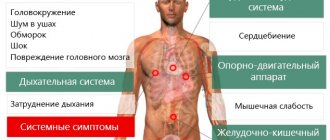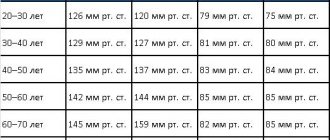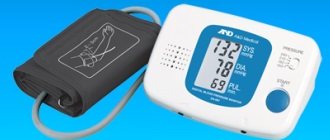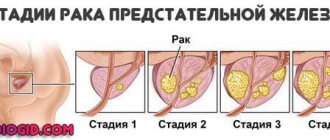Types of blood pressure
Blood pressure is a variable value; its normal values vary depending on heartbeat cycles, physical activity, emotional and hormonal fluctuations, and time of day. As a rule, the highest blood pressure numbers are recorded during daytime activity, the lowest during deep sleep at night.
Types of blood pressure:
- Systolic (upper) pressure. The maximum blood pressure on the walls of the arteries during systole is the contraction of the heart muscle of the right and left ventricles and the release of blood into the pulmonary trunk and aorta. Systolic pressure is the first digit in the blood pressure record.
- Diastolic (lower) pressure. The lowest level of blood pressure on the walls of blood vessels is during diastole - relaxation of the muscles of the atria and ventricles, during which the heart fills with blood. Depends on vascular resistance. The diastolic pressure numbers in the blood pressure record are in second place.
- Pulse pressure is the difference between systolic and diastolic pressure.
Medical normal blood pressure
Blood pressure is measured in millimeters of mercury (mmHg). Normal blood pressure levels vary depending on the age, weight and state of health of a person, but in general there are generally accepted standards, based on which the doctor can conduct an initial diagnosis, assess the patient’s well-being, the absence or presence of certain problems. Medical blood pressure standards are the same for men and women.
Medical pressure standards
| Category | Systolic blood pressure (mm Hg) | Diastolic blood pressure (mm Hg) |
| Optimal | up to 120 | up to 80 |
| Normal | 120-129 | 80-84 |
| High normal | 130-139 | 85-89 |
| Arterial hypertension stage 1. | 140-159 | 90-99 |
| Arterial hypertension stage 2. | 160-179 | 100-109 |
| Arterial hypertension stage 3. | from 180 and above | from 110 and above |
| Isolated systolic hypertension | more than 140 | less than 90 |
Monitoring and correction of blood pressure
Optimal and normal blood pressure does not require constant monitoring. For people with such blood pressure indicators, it is enough to measure it periodically, during routine medical examinations, medical examinations, and visits to the doctor for other reasons.
High normal blood pressure (HNBP) is not an independent disease or risk factor, but is considered as a condition in which early primary prevention of arterial hypertension and associated complications is possible. The maximum predisposition to high normal blood pressure is found in men aged 40 to 59 years with a high body mass index. They are advised to control blood pressure somewhat more often than standard recommendations, get rid of bad habits, and normalize weight.
Arterial hypertension of the 1st degree is often asymptomatic and remains undetected for a long time. If its signs are accidentally detected, for example, during a routine examination, the patient is recommended to undergo 24-hour blood pressure monitoring in order to exclude the “white coat” syndrome – increased blood pressure due to anxiety and fear of doctors. When the diagnosis is confirmed, the patient needs regular observation by a local doctor and periodic self-measurement of blood pressure. Arterial hypertension of the 1st degree does not always require pharmacological therapy. Often, lifestyle adjustments help stabilize blood pressure: proper nutrition and normalization of weight, giving up bad habits, moderate physical activity, and lack of stress.
In case of arterial hypertension of 2 and 3 degrees, isolated systolic hypertension, constant (most often daily) independent monitoring of blood pressure is required. To correct these conditions, in addition to lifestyle changes, drug therapy is required, which is carried out only as prescribed and under the supervision of a doctor.
Symptoms of incipient hypertension
At this stage of the disease, the symptoms are often blurred and the person practically does not feel the manifestations of hypertension, learning about the problem during a routine examination with a doctor. But usually a pressure of 140 over 80 is accompanied by characteristic symptoms. This:
- often headaches in the back of the head or temples;
- sleep is disturbed;
- periodic heart pain occurs;
- the heartbeat becomes unstable, tachycardia (pulse 90–100 and above) or bradycardia (pulse below 60 beats per minute) develops;
- “floaters” appear before the eyes and noise in the ears;
- hypertension is characterized by shortness of breath with minimal physical exertion;
- An increase in upper blood pressure may be accompanied by nausea and vomiting.
If such symptoms appear, you should consult a doctor. He will be able to determine the cause of high blood pressure, the severity of the condition, and then prescribe the optimal treatment regimen, taking into account the characteristics of each patient.
Important! What pressure is normal for each patient is an individual question. You cannot follow the standard 120/80, since this norm is relevant only for young people whose medical history is not burdened by other disorders in the functioning of internal organs and systems.
Table of BP (blood pressure) by age
Blood pressure norms depending on gender and age
Blood pressure is higher in adults than in children; it differs between men and women. In women, changes in blood pressure are affected by pregnancy and menopause.
Blood pressure norms for men and women
Age (years) Systolic blood pressure (mm Hg) Diastolic blood pressure (mm Hg) male wives husband. wives 10-20 123 116 76 72 20-30 126 129 79 75 30-40 129 127 81 80 40-50 135 137 83 84 50-60 142 144 85 85 60-70 145 159 82 85 70- 80 147 157 82 83 80 -90 145 150 78 79Often young people under 35 years of age do not notice symptoms of high blood pressure. However, they can also develop arterial hypertension, so periodic monitoring in case of existing risk factors and the appearance of complaints is mandatory for timely diagnosis, prevention and treatment if necessary.
In childhood, the walls of blood vessels are more elastic, so normal blood pressure in children is lower than in adults. The indicator increases as the child grows. The most significant change in blood pressure values is observed from birth to one year. Girls and boys have the same blood pressure, the difference appears towards the end of puberty.
Blood pressure norms in children
| Age | Systolic blood pressure (mm Hg) | Diastolic blood pressure (mm Hg) |
| newborns | 60-96 | 40-50 |
| from 2 months up to a year | 80-112 | 50-74 |
| 1-2 years | 82-115 | 61-75 |
| 2-3 years | 85-116 | 60-76 |
| 3-4 years | 90-118 | 60-78 |
| 4-5 l. | 95-120 | 60-80 |
| 5-6 l. | 100-122 | 60-80 |
| 6-8 l. | 110-122 | 70-82 |
| 8-11 l. | 110-126 | 70-82 |
| 12-15 l. | 110-136 | 70-86 |
| 15-16 l. | 110-136 | 70-90 |
| 16-18 l. | 110-120 | 80-90 |
Symptoms
A blood pressure level of 130 over 70 is not considered by doctors to be a pathological condition. But a certain group of people, due to the characteristics of the body, tolerate this small jump in blood pressure very poorly.
Typical symptoms of high blood pressure:
- attacks of nausea, sometimes ending in vomiting;
- active sweating;
- poor sleep, poor concentration;
- tachycardia;
- trembling of hands and feet;
- feeling of discomfort behind the sternum;
- headache;
- flickering of flies before the eyes.
Important! In some cases, loss of consciousness is possible.
If such symptoms develop, you should consult a doctor, as they indicate a dysfunction of the body. With timely diagnosis and timely treatment, the development of serious diseases can be avoided.
How to measure blood pressure correctly
A special device is used to measure blood pressure - a tonometer. Tonometers are manual (mechanical), semi-automatic and automatic.
Selecting a tonometer
The manual one consists of a shoulder cuff, an air pump (bulb), a stethoscope, and a pressure gauge. The semi-automatic tonometer contains a cuff, a bulb and an electronic unit. An automatic tonometer pumps air on its own and consists only of a cuff and an electronic unit.
It is difficult to measure pressure on your own with a manual tonometer; you will need the help of a person with the necessary skill. However, measurement with a manual tonometer is considered the most accurate. Most often it is used by doctors. Semi-automatic and automatic devices allow you to monitor blood pressure at home or at work without difficulty and outside assistance.
Rules for measuring blood pressure
To obtain the most accurate result, the following rules must be observed:
- the measurement should be carried out in a quiet environment, in a quiet room at room temperature;
- After eating, physical activity, smoking, at least 30 minutes must pass before the procedure;
- Do not drink tea or coffee before measurement;
- Blood pressure should be measured while sitting in a comfortable natural position, the hand should rest on a support approximately at the level of the heart, and be as relaxed as possible;
- During the measurement, you cannot keep your legs crossed, move or talk;
- Blood pressure should be measured on both arms with a break of 10-15 minutes;
- When taking antihypertensive drugs, 1-2 hours should pass before measuring blood pressure.
The results must be recorded in a special diary, noting the date, time of measurement, circumstances that may affect the result - poor sleep, malaise, taking medications.
How often should you measure your blood pressure?
If a person associates poor health with high blood pressure, to confirm this fact it is necessary to measure it for several days in a row, repeatedly during the day at approximately the same hours - usually in the morning and evening, unless a different frequency of measurements is recommended by the doctor. It is recommended to take 2-3 measurements at a time with an interval of 2-3 minutes.
Daily blood pressure measurements are also recommended in other cases. These include:
- first identified fact of increased blood pressure;
- changing the treatment regimen for arterial hypertension (changing drugs or their dosage);
- increased blood pressure during antihypertensive therapy;
- cardiovascular diseases, in addition to arterial hypertension;
- taking medications for other diseases that may affect blood pressure levels.
Reasons for deviation of blood pressure from normal
Blood pressure numbers may be lower or higher than accepted norms. If changes in indicators are recorded repeatedly and are not associated with external influences (heat or cold, stress, physical activity before measurement) or malfunction of the tonometer, they speak of hypotension (low blood pressure) or hypertension (high blood pressure). Hypertension is diagnosed more often than hypotension; among the entire population, the ratio is about 40% and 5%, respectively.
Hypotension – decrease in blood pressure to 100/60 mm. rt. Art. and less. Accompanied by weakness, dizziness, drowsiness, sweating, shortness of breath, memory impairment.
Hypertension is a rise in blood pressure above 140/90 mm. rt. Art. Characterized by headache, dizziness, pain in the heart, sleep and vision disturbances.
Hypotension or hypertension can be a consequence of both general causes and pathologies of the cardiovascular and other body systems.
Common reasons:
- chronic stress, depression;
- poor diet, excess weight or exhaustion;
- smoking and alcohol abuse;
- sedentary lifestyle or high physical activity;
- lack of vitamins and microelements.
Pathological conditions:
- weakness of the heart muscle;
- decreased elasticity of blood vessels;
- blood thickening;
- diabetes mellitus, other endocrine diseases;
- glomerulonephritis.
Is this kind of blood pressure dangerous?
A blood pressure of 130/70 is called prehypertension, which means it is minimally above the upper limit of normal. If you do not change your lifestyle, then with such tonometer readings, there is a possibility of developing arterial hypertension. This significantly increases the risk of serious cardiovascular diseases such as heart attack, stroke, heart failure and dementia.
Prehypertension cannot be considered life-threatening. It serves as a signal to change your attitude towards your own health. Once you start exercising or change your diet towards healthier foods, the increase will disappear.
And also read on our website: What does blood pressure 90 over 80 mean, what to do, how to raise low levels, what to take?
The danger arises in the presence of discomfort and various ailments, such as lethargy, numbness of the limbs or migraines. In this case, you should urgently consult a doctor, since such signs may indicate the development of pathological processes.
In pregnant women
During pregnancy, a woman is obliged to monitor her blood pressure, as this affects the body of the developing fetus. A blood pressure of 130/70 is considered the border between normal and pathological for women carrying a child, since the slightest manifestation of hypertension is regarded as gestosis and will require hospitalization. If a pregnant woman feels unwell and uncomfortable at 130/70, a doctor should be called immediately.
Prevention
Prevention of blood pressure deviations from normal values primarily consists of lifestyle modifications that can prevent the development of the disease. The recommendations must be followed by people with a family history who are at risk (excess weight, frequent stress).
To prevent hypotension, night sleep should be normalized - it should be at least 8 hours, include dishes with a high content of calcium, potassium and magnesium in the menu, eat often in small portions, limit animal fats and fast carbohydrates, and ensure sufficient physical activity.
To maintain normal blood pressure, people with a tendency to high blood pressure need to follow a clear daily routine, exclude fried, fatty, salty and spicy foods from the menu, reduce excess weight, and provide moderate physical activity.
In both cases, it is important to give up smoking and alcohol, avoid physical inactivity, night vigils, and reduce stress levels.
Treatment methods
If you are diagnosed with arterial hypertension, it means that you will have to take full responsibility for your own health. It is impossible to achieve positive dynamics of treatment by washing down antihypertensive pills with beer and eating fried potatoes.
As long as upper pressure readings are at 140–142–144 mm Hg, there is a high probability that the problem can be solved without the use of potent tablets. First of all, it is necessary to eliminate the factors that contribute to the development of the disease and increase the upper pressure.
The recommendations are as follows:
- Quit smoking and alcohol completely. An exception is dry red wine, which increases the elasticity of blood vessels.
- Play sports to prevent complications of physical inactivity, including heart attack, stroke, and heart failure. Physical activity in the fresh air is especially useful, for example, morning jogging and leisurely walks before bed.
- Lose excess weight, which has a detrimental effect on the condition of the entire body as a whole.
- Adjust your diet in favor of foods that are healthy for your blood vessels, replace animal fats with vegetable fats, buy a double boiler to cook not only healthy, but also tasty dishes.
- Do not forget to be regularly examined and promptly treat diseases that can cause the development of arterial hypertension.
Important! You need to know how to reduce high blood pressure in an emergency. The tablets are selected individually by the doctor. With a sharp jump in blood pressure, they can not only improve your well-being, but save your life.
Non-drug methods will help to level blood pressure boundaries:
- sauna (with mandatory heart rate monitoring);
- medicinal baths (radon, hydrogen sulfide);
- UHF therapy;
- electrophoresis;
- massage;
- electrosleep.
Herbal infusions that have a diuretic and sedative effect are highly effective. If hypertension progresses, then it is no longer possible to do without daily medication. Among the most popular groups of drugs are ACE inhibitors, calcium antagonists, diuretics, alpha blockers, beta blockers.
The drug treatment regimen should take into account that lower pressure is normal and there is no need to reduce it. Therefore, it is strongly not recommended to choose a drug for yourself, focusing on advertising calls and reviews of friends.
Pulse pressure and heart rate
The difference between systolic and diastolic blood pressure is called pulse pressure. It changes depending on a person’s age, well-being and emotional state, and external factors. Knowing the value of pulse pressure, the doctor can judge the condition of the heart muscle and valves, vessel walls and their patency. The normal difference between the upper and lower pressure is from 30 to 50 mm. rt. Art.
Low pulse pressure (less than 30 mmHg) is accompanied by headaches, dizziness, drowsiness, weakness, even loss of consciousness. This condition may indicate the development of:
- vegetative-vascular dystonia;
- anemia;
- sclerotic changes in CCC;
- aortic stenosis;
- myocarditis;
- kidney diseases.
High pulse pressure (more than 60 mmHg) has symptoms characteristic of the pathology whose development causes it. Its reasons may be:
- congenital and acquired heart defects;
- endocarditis;
- cardiac ischemia;
- atherosclerosis;
- hypertension;
- thyrotoxicosis;
- fever;
- increased intracranial pressure.
Pulse
Heart rate (HR, pulse) is an important indicator of the functioning of the cardiovascular system. It is measured in the number of beats in one minute.
Pulse rates differ between children and adults. In general, the heart rate values in women and men are approximately equal, however, women during pregnancy, menopause, and other hormonal changes may experience tachycardia - an increase in heart rate, which is considered a variant of the norm.
Athletes involved in aerobic sports (running, swimming, cycling), due to good training and sometimes hypertrophy of the heart muscle, have a pulse rate lower than that of ordinary people and is 40-60 beats per minute.
Possible complications of pathology
If the pressure of 130 to 60 is unstable, then no pronounced pathological changes occur. However, with long-term and constant detection of values, it is necessary to consult a therapist or cardiologist. The most common complications of a high pulse difference are:
- Increased risk of developing emergency cardiac pathologies and cerebrovascular accidents.
- Intensive decrease in the tone and elasticity of the arteries.
- Disorders of kidney and liver function.
- Dysregulation of the nervous system.











